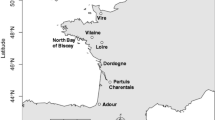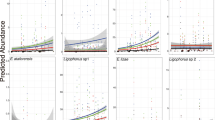Abstract
Are the distribution of Mazocraes alosae and its impact on the host similar between Alosa alosa and A. fallax according to their resemblances? Parasites were numbered on each gill of shads sampled in North-East Atlantic coastal waters and connected rivers. Their impact on host condition was measured using girth, gonado-somatic ratio, C/N ratio, and Fulton’s K. Prevalence and mean intensity of M. alosae were significantly higher for A. alosa than for A. fallax, including in sympatric conditions. The mean intensity varied among sites whatever fish species; it was higher in coastal–estuarine versus fresh waters only for A. fallax. The distribution of M. alosae was aggregated in the host population whatever species. At the host individual level, some gills (second and third for A. alosa, second for A. fallax) were significantly more inhabited than others, probably in relation with larger water volumes flowing on these gills and mazocraeid sedentary lifestyle. Despite high prevalence and intensity, no negative impact of M. alosae was demonstrated on the host condition whatever the index considered. Our study underlines the major occurrence of M. alosae on shads and the potential use of such benign parasite as biological tag to discriminate closely related host species.


Similar content being viewed by others
References
Acou, A., E. Lasne & E. Feunteun (coord.), 2013. Programme de connaissance Natura2000 en mer: les habitats marins des espèces amphihalines. Evaluation de la cohérence du réseau Natura2000 en mer pour la grande alose (Alosa alosa), l’alose feinte (A. fallax sp.), la lamproie marine (Petromyzon marinus) et la lamproie fluviatile (Lampetra fluviatilis). Rapport préliminaire du Muséum National d’Histoire Naturelle, Station marine de Dinard.
Alexandrino, P., R. Faria, D. Linhares, F. Castro, M. Le Corre, R. Sabatié, J. L. Baglinière & S. Weiss, 2006. Interspecific differentiation and intraspecific substructure in two closely related clupeids with extensive hybridization, Alosa alosa and Alosa fallax. Journal of Fish Biology 69: 242–259.
Aprahamian, M. W., 1985. The effect of the migration of Alosa fallax fallax (Lacépède) into fresh water, on branchial and gut parasites. Journal of Fish Biology 27: 521–532.
Aprahamian, M. W., C. D. Aprahamian, J. L. Baglinière, R. Sabatié & P. Alexandrino, 2003. Alosa alosa and Alosa fallax spp. literature review and bibliography. R&D Technical Report W1 014/TR. Environment Agency, Bristol.
Baglinière J. L. & P. Elie, 2000. Les aloses (Alosa alosa et Alosa fallax spp.): Ecobiologie et variabilité des populations. CEMAGREF-INRA, Paris.
Barnes, C., C. J. Sweeting, S. Jennings, J. T. Barry & N. V. C. Polunin, 2007. Effect of temperature and ration size on carbon and nitrogen stable isotope trophic fractionation. Functional Ecology 21(2): 356–362.
Barzegar, M., A. Bozorgnia, M. R. Youssefi & S. M. Hosseinifard, 2012. Determination of Alosa caspia persica parasites in fresh and brine water of Caspian Sea. World Journal of Fish and Marine Sciences 4(2): 175–178.
Bates D., M. Maechler, B. Boler & S. Walker, 2014. lme4: linear mixed-effects models using Eigen and S4. R package version 1.1–7.
Benjamini, Y. & Y. Hochberg, 1995. Controlling the false discovery rate: a practical and powerful approach to multiple testing. Journal of the Royal Statistical Society Series B 57: 289–300.
Buchmann, K. & J. Bresciani, 2006. Monogenea (phylum Platyhelminthes). In Woo, P. T. K. (ed.), Fish diseases and disorders, Vol. 1., Protozoan and metazoan infections CABI Publishing, Wallingford: 297–344.
Bush, A. O., K. D. Lafferty, J. M. Lotz & A. W. Shostak, 1997. Parasitology meets ecology on its own terms: Margolis et al. revisited. Journal of Parasitology 83: 575–583.
Bychowsky, B. E., 1957. Monogenetic Trematodes their systematics and phylogeny. In Hargis, Jr. W. J. (ed.), Translated by Oustinoff P. C. American Institute of Biological Sciences, Washington, DC.
Chapman, L. J., C. A. Lanciani & C. A. Chapman, 2000. Ecology of a diplozoon parasite on the gills of the African cyprinid Barbus neumayeri. African Journal of Ecology 38: 312–320.
Combes, C., 1995. Interactions durables. Écologie et évolution du parasitisme. Masson, Paris.
Doherty, D., N. O’Maoiléidigh & T. K. McCarthy, 2004. The biology, ecology and future conservation of Twaite shad (Alosa fallax Lacépède), Allis shad (Alosa alosa L.) and Killarney shad (Alosa fallax fillarnensis Tate Regan) in Ireland. Biology and Environment. Proceedings of the Royal Irish Academy 104B(3): 93–102.
Gutiérrez, P. & S. R. Martorelli, 1999. Hemibranch preference by freshwater monogeneans a function of gill area, water current, or both? Folia Parasitologica 46: 263–266.
Hayward, C., 2005. Monogenea Polyopisthocotylea (ectoparasitic flukes). In Rohde, K. (ed.), Marine Parasitology. Csiro Publishing, Clayton: 55–63.
Kearn, G. C., 1998. Parasitism and the Platyhelminths. Chapman & Hall, London.
Kennedy, C. R., 2009. The ecology of parasites of freshwater fishes: the search for patterns. Parasitology 136: 1653–1662.
Lenth, R. & M. Hervé, 2015. lsmeans: least-squares means. R package version 2.14.
MacKenzie, K. & P. Abaunza, 1998. Parasites as biological tags for stock discrimination of marine fish: a guide to procedures and methods. Fisheries Research 38: 45–56.
Neff, B. D. & L. M. Cargnelli, 2004. Relationships between condition factors, parasite load and paternity in bluegill sunfish, Lepomis macrochirus. Environmental Biology of Fishes 71: 297–304.
Paling, J. E., 1968. A method of estimating the relative volumes of water flowing over the different gills of a freshwater fish. Journal of Experimental Biology 48: 533–544.
Pante, E. & B. Simon-Bouhet, 2013. Marmap: a package for importing, plotting and analyzing bathymetric and topographic data in R. PLoS One 8: e73051.
R Core Team, 2014. R: A Language and Environment for Statistical Computing. R Foundation for Statistical Computing, Vienna, Austria. http://www.R-project.org/.
Rohde, K., 1979. A critical evaluation of intrinsic and extrinsic factors responsible for niche restriction in parasites. The American Naturalist 114(5): 648–671.
Santos, M. J., A. Saraiva, C. Cruz, J. C. Eiras, M. Hermida, C. Ventura & J. P. Soares, 2009. Use of parasites as biological tags in stock identification of the black scabbardfish, Aphanopus carbo Lowe, 1839 (Osteichthyes: Trichiuridae) from Portuguese waters. Scientia Marina 73(S2): 55–62.
Taverny, C. & P. Elie, 2001. Répartition spatio-temporelle de la grande alose Alosa alosa (Linné, 1766) et de l’alose feinte Alosa fallax (Lacépède, 1803) dans le Golfe de Gascogne. Bulletin Français de la Pêche et de la Pisciculture 362(363): 803–821.
Wootten, R., 1974. The spatial distribution of Dactylogyrus amphibothrium on the gills of ruffe Gymnocephalus cernua and its relation to the relative amounts of water passing over the parts of the gills. Journal of Helminthology 48: 167–174.
Yamamoto, K., S. Takagi & S. Matsuoka, 1984. Mass mortality of the Japanese anchovy (Engraulis japonica) caused by a gill monogenean Pseudanthocotyloides sp. (Mazocraeidae) in the Sea of Iyo (“Iyo-nada”), Ehime Prefecture. Fish Pathology 19: 119–123.
Acknowledgments
This study was funded by the French Ministry of Ecology and Sustainable Development (‘Programme de connaissances Natura2000 amphihalins en mer’). Authors warmly thank the numerous fishermen and local angling federation for providing the fish. We are also grateful to the colleagues (E. Chavance, E. Sola, and T. Lavigne) who collaborated on the study. We gratefully acknowledge Valérie Briand (UMR ECOBIO 6553) for her bibliographical support.
Author information
Authors and Affiliations
Corresponding author
Ethics declarations
Conflict of interest
All of the authors read and approved the paper that has not been published previously nor is being considered by any other peer-reviewed journal. The authors declare that there are no conflicts of interest.
Additional information
Handling editor: M. Power
Rights and permissions
About this article
Cite this article
Gérard, C., Hervé, M., Réveillac, E. et al. Spatial distribution and impact of the gill-parasitic Mazocraes alosae (Monogenea Polyopisthocotylea) on Alosa alosa and A. fallax (Actinopterygii, Clupeidae). Hydrobiologia 763, 371–379 (2016). https://doi.org/10.1007/s10750-015-2391-1
Received:
Revised:
Accepted:
Published:
Issue Date:
DOI: https://doi.org/10.1007/s10750-015-2391-1




